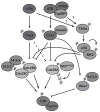Kinases that control the cell cycle in response to DNA damage: Chk1, Chk2, and MK2
- PMID: 19230643
- PMCID: PMC2699687
- DOI: 10.1016/j.ceb.2009.01.018
Kinases that control the cell cycle in response to DNA damage: Chk1, Chk2, and MK2
Abstract
In response to DNA damage eukaryotic cells activate cell cycle checkpoints -- complex kinase signaling networks that prevent further progression through the cell cycle. Parallel to implementing a cell cycle arrest, checkpoint signaling also mediates the recruitment of DNA repair pathways. If the extent of damage exceeds repair capacity, additional signaling cascades are activated to ensure elimination of these damaged cells. The DNA damage response has traditionally been divided into two major kinase branches. The ATM/Chk2 module is activated after DNA double strand breaks and the ATR/Chk1 pathway responds primarily to DNA single strand breaks or bulky lesions. Both pathways converge on Cdc25, a positive regulator of cell cycle progression, which is inhibited by Chk1-mediated or Chk2-mediated phosphorylation. Recently a third effector kinase complex consisting of p38MAPK and MK2 has emerged. This pathway is activated downstream of ATM and ATR in response to DNA damage. MK2 has been shown to share substrate homology with both Chk1 and Chk2. Here we will discuss recent advances in our understanding of the eukaryotic DNA damage response with emphasis on the Chk1, Chk2, and the newly emerged effector kinases p38MAPK and MK2.
Figures


References
-
- Abraham RT. Cell cycle checkpoint signaling through the ATM and ATR kinases. Genes Dev. 2001;15:2177–2196. - PubMed
-
- Bartek J, Lukas J. Chk1 and Chk2 kinases in checkpoint control and cancer. Cancer Cell. 2003;3:421–429. - PubMed
-
- Harper JW, Elledge SJ. The DNA damage response: ten years after. Mol Cell. 2007;28:739–745. - PubMed
-
- Kastan MB, Bartek J. Cell-cycle checkpoints and cancer. Nature. 2004;432:316–323. - PubMed
-
- Shiloh Y. ATM and related protein kinases: safeguarding genome integrity. Nat Rev Cancer. 2003;3:155–168. - PubMed
Publication types
MeSH terms
Substances
Grants and funding
LinkOut - more resources
Full Text Sources
Other Literature Sources
Molecular Biology Databases
Research Materials
Miscellaneous

